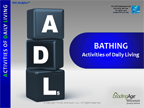
Web Demo
Module 1:
Documenting & Measuring ADLs
ADL Analytics™
|
ADLs are the key to your database accuracy and proper RUG payment. As such, you need to be aware of the documentation process in your facility that creates the scoring in MDS Section “G” for bed mobility, transfer, eating, and toilet use.
ADL coding is a complex process that involves many staff members, and has a significant impact on quality measures and reimbursement. But if you get ADLs right, accurate ADL coding will result in better Quality Measures, can improve the 5-Star ranking, and provides appropriate reimbursement for the care that is actually delivered.
Intended Audience: Care professionals, including Nurses, Nurse Assistants, MDS/Care Coordinators, Therapists, Staff Educators, Social Workers and Activities Staff will benefit from the guidelines and tips provided in these training modules.
Presenter: Tina Schrader-Berte, CEO / President, Reimbursement & Outcomes Services, Pro Ed Continuum LLC, New Berlin, Wisconsin
Estimated length of each unit: 15-20 minutes
- Unit 1 – Bed Mobility
- Unit 2 – Toileting
- Unit 3 – Transfer
- Unit 4 – Eating
- Unit 5 – Walk in Room & Walk in Corridor
- Unit 6 – Locomotion On and Off Unit
- Unit 7 – Dressing
- Unit 8 – Personal Hygiene
- Unit 9 – Bathing
- Unit 10 – Coding for ADLs
|
.png)
Module 2:
Documenting and Measuring Moods & Behaviors
Case Mix Analytics™
|
In RUG-IV, 26 RUG groups are affected by depression indicators. This compares with only six RUG groups under RUG-III (Clinically Complex). The average cost of missing a depression indicator end-split has increased. More specifically, under RUG-III rates, missing a depression end-split costs, on average, about $15 per day in lost reimbursement. Under RUG-IV, missing a depression end-split on a staff assessment will cost, on average, more than $52 per day, an increase of more than $37 per day.
Mood & Behavioral Symptom – Presence and Frequency, may seem relatively straightforward; however, some facilities continue to struggle to code these items correctly. The first step is ensure facility staff know how to recognize mood and behavior symptoms and how to accurately docuemnt indicators.
Presenter: Tina Schrader-Berte, CEO / President, Reimbursement & Outcomes Services, Pro Ed Continuum LLC, New Berlin, Wisconsin
Intended Audience: Care professionals, including Nurses, MDS / Care Coordinators, Staff Educators, and Social Workers will benefit from the guidelines and tips provided in these training modules.
Estimated length of each unit: 15-20 minutes
- Unit 1 – Documentation and Coding for Mood Indicators
- Unit 2 – Documentation and Coding for Behavior Symptoms
|
.png)
Module 3:
Looking at Key Performance Indicators for PPS & Case Mix Reimbursement Outcomes
Case Mix Analytics™
|
It is imperative that you determine the efficiency of your data collection.
The regulatory and payment systems with which you work are dependent on the electronic data submitted through the MDS and billing process. Internal electronic systems need to be efficient, not only to document the data for MDS transmissions and billing, but also to create useful database reports to help managers and members of the interdisciplinary team to track the care provided, resource utilization, outcomes, and the payment process for each resident.
What kind of reports should you utilize?
Your MDS and payment database feed into your total operations. Your MDS software vendor should be able to provide reports that relate to building operations, resident services, outcome tracking, and risk avoidance.
Presenter: Tina Schrader-Berte, CEO / President, Reimbursement & Outcomes Services, Pro Ed Continuum LLC, New Berlin, Wisconsin
Intended Audience: Health Leadership teams including Directors of Operations, Clinical Directors, Financial Directors, and Administrators will benefit from the strategies and tips provided in these training modules.
Estimated length of each unit: 15-20 minutes
- Unit 1 – Defining Performance Benchmarks
- Unit 2 – Establishing Key Performance Indicators
- Unit 3 – Making Sense out of Performance Metrics
|
.png)
Module 4:
Resident Assistant Documentation in Assisted Living - WI
Pinnacle Innovative Health Care Solutions, LLC
|
Requirements for documentation in the Assisted Living setting are less defined than the requirements for documentation in the skilled nursing setting; however, the documentation itself is no less important. The documentation that is done by both the licensed nursing staff and the direct care workers is essential in evaluating and demonstrating that we are effectively addressing and meeting the needs of the resident/tenant. Accurate and timely documentation helps to ensure that the resident or tenant is being cared for at the appropriate level and in the appropriate setting within regulatory guidelines. Effective documentation is a vital communication tool and provides the framework for quality assurance in assisted living.
Presenter: Amy Ruedinger, Founder & President, Pinnacle Innovative Health Care Solutions, LLC, Black Creek, Wisconsin
Intended Audience: Assisted Living Professionals, including Nurses, Caregivers, Social Workers, and Activity Directors will benefit from the guidelines and tips provided in these training modules.
Estimated length of each unit: 15-20 minutes
- Unit 1 – Documentation: Purpose and Requirements
- Unit 2 – Documentation: Professional Standards and
Key Components
- Unit 3 – Documentation: Resident/Tenant Conditions
and Concerns
- Unit 4 – Documentation: The Resident Medical
Record and Incident Report
- Unit 5 – Documentation and Quality Assurance
|
|

.png)
.png)
.png)
